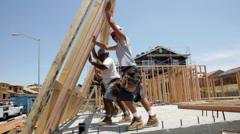Why technology has not transformed building

Emma Woollacott,Technology Reporter
 Getty Images
Getty ImagesIf you took a worker from a 1920s construction site and transported them to a present day project, they would not be that surprised by what they saw, according to Sam O’Gorman.
“Overall, across Europe and the US, stuff is still built in a pretty manual fashion – not very different to the way it would have been built 100 years ago,” says Mr Gorman, an associate partner in the property practice of consultancy firm McKinsey.
Back in 2017, the McKinsey Global Institute concluded that the construction industry could improve productivity by 50 to 60% and boost the industry’s global value by $1.6tn (£1.3tn) a year.
Since then, McKinsey says, improved production processes and the use of new software and apps have improved efficiency, but not to the extent that one might have hoped.
“Construction is a bit of a digital laggard compared with many other industries. It’s been slow to adopt digital in the widest sense,” says Mr O’Gorman.
In recent years, several technologies have been touted as having the potential to transform the industry. One of those is 3D printing, which involves extruding concrete or other materials to build up the walls of a house.
The University of Maine has been working on one such project, developing the world’s biggest 3D printer.
Using a mix of wood fibers and plant-based resin, the printer formed a 600 sq ft (180 sq m) house.
“The first prototype home, BioHome3D, has performed very well through two Maine winters, and we are turning our attention now to printing a neighbourhood consisting of nine of these homes,” says Dr Habib Dagher, executive director of the University of Maine’s Advanced Structures and Composites Center.
However, 3D printing of homes remains more of a demonstration project, rather than a practical proposition. 3D printed homes tend to be expensive, to have extremely thick walls, and are hard to construct on anything other than an open, flat site.
While there have been a number of much-vaunted 3D-printed construction projects, the number of houses actually built this way remains tiny.
 University of Maine
University of MaineMr O’Gorman and Dr Dagher say that another technique, modular construction, could make building more efficient.
It involves manufacturing parts of the building in a factory, transporting them to the site and lifting them into place.
“I’m convinced that it is the future, the quality of construction is so much better. On a construction site you get so many little errors,” Dr Dagher says.
“The more you can do in a factory, the better. Quality control is clearly so much superior, and the quality of the finish as well.”
However, this technology, too, has failed to take off, says Neil Jefferson, managing director of the UK Home Builders Federation.
“The problem with manufacturing housing is that you book your stuff in the factory to build those homes, and the materials arrive and you need to stick to the plan,” he says.
“But at the moment in this country, because of the government’s approach to planning policy, projects are beset with delays. And that just doesn’t work, you need a more flexible approach.”
Developers need a certain amount of confidence that they’ll be able to sell their houses quickly once complete, and often need to alter plans as a project continues as the market changes. This is less of an issue with projects for local authorities or housing associations, but can be a problem for private developers.
 AUAR
AUAROne company aiming to sidestep some of these problems is Bristol-based Automated Architecture, or AUAR, which is planning to license micro-factories to build timber houses using robots.
These micro-factories will create buildings of up to six storeys that are assembled from standard parts, either at the factory itself or on site.
The idea is that larger construction firms can license a microfactory with an upfront cost of around £250,000 and an ongoing monthly fee.
“AUAR’s partners don’t need to invest millions in setting up large factories, as modular housing companies do, but can immediately offer innovative, high quality, low-energy homes at market rates to their customers,” says Mollie Claypool, co-founder and chief executive.
The automation, she says, creates higher margins for developers, along with faster build times and a reduction in risk and waste. Labour costs per project, she says, can be between 20% and 60% lower than when traditional construction methods are used.
The company already has four customers lined up, she says, and is aiming to boost that number to 140 by 2030, building more than 30,000 energy-efficient homes per year.
While the home construction industry hasn’t seen the same sort of major transformation as other industries, a lot of the smaller, less-visible parts of the process are being digitised.
“The bit that gets the most news and interest is the actual construction bit – it’s pretty analogue and hasn’t changed a lot. If you look at the rest of the chain, it is actually digitising quite nicely,” says Mr O’Gorman.
“People are using digital tools to identify land, using AI to predict future values, using a whole host of different metrics. The design process has gone quite digital over the last 10 years.”
And it’s these types of behind-the-scenes improvements that are likely to do most to streamline the home-building process, says Karoliina Torttila, director of AI at industrial technology firm Trimble.
Work that was once recorded in paperwork and filing cabinets has now been digitised. So, quantity surveying, health and safety procedures, commissioning and handover work and carbon emission management, can all be done on apps and computer software.
However, more can be done.
“A big challenge is that the construction industry is highly fragmented, making it hard to implement uniform technological advances,” says Ms Torttila.
The primary contractor manages many sub-contractors – mechanical, electrical, plumbing, finishing work, earthworks and more. Each team is affected by the other teams’ plans and the way they’re put into practice, with errors made in the field often having a dramatic impact on cost in the later stages.
But technology could help mitigate those problems. On a big construction project, creating a 3D model of the building or any components, which everyone can share, could help discover any discrepancies, before they become a bigger problems, says Ms Torttila.
“Such actionable data not only encourages communication between teams on the construction and back office operations, but also informs forecasting, planning, and purchasing decisions,” she says.
“This helps create a smoother process – even if the industry remains fragmented.”

